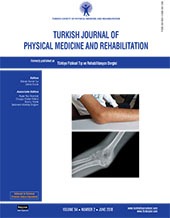Psychiatric comorbidity and childhood trauma in fibromyalgia syndrome
2 Department of Psychiatry, Kocaeli University School of Medicine, Kocaeli, Turkey
3 Department of Psychiatry, Erenkoy Mental Health and Psychiatry Training and Research Hospital, İstanbul, Turkey
4 Department of Psychiatry, İstanbul Moodist Psychiarty and Neurology Hospital, İstanbul, Turkey
5 Department of Physical Medicine and Rehabilitation, Kocaeli University School of Medicine, Kocaeli, Turkey DOI : 10.5606/tftrd.2018.1470 Objectives: In this study, we aimed to compare patients with fibromyalgia syndrome (FMS) and those with myofascial pain syndrome (MPS) and healthy women and to investigate the prevalence of childhood traumatic experiences (CTEs) in relation to comorbid mood and anxiety disorders.
Patients and methods: Between February 2014 and May 2014, a total of 136 women including 52 with FMS, 35 with MPS, and 49 healthy controls were included in the study. The Sociodemographic Data Form, Mood and Anxiety Disorders Modules of Structured Clinical Interview for Diagnostic and Statistical Manual of Mental Disorders fourth edition (DSM-IV) Axis I Disorders (SCID-I), Fibromyalgiarelated Symptom Scale (FSS), Hamilton Depression Rating Scale (HDRS), Hamilton Anxiety Rating Scale (HARS), and Childhood Trauma Questionnaire-28 (CTQ-28) were applied to participants.
Results: As a result of the semi-structured clinical interview conducted by a psychiatrist experienced in psychological trauma, the prevalence of any mood or anxiety disorder were found to be significantly more common in the FMS group. Childhood traumatic experiences, not only in general, but also with all subtypes, were also reported to be significantly more in FMS patients. Besides, only in patients with FMS, a significant relationship was found between the psychiatric diagnoses and the presence of CTEs. Furthermore, the CTQ-28 scores were correlated positively with the FSS scores as well as HDRS and HARS. Among the symptoms screened by the FSS, only crying and over-reacting to incidents were significantly associated with CTEs in FMS group.
Conclusion: Based on our study results, CTEs may play a critical role in the development of fibromyalgia and may be related with comorbid mood and anxiety disorders in FMS patients. Associating psychological symptoms such as crying or over-reacting to incidents in FMS patients should be, therefore, alerting for psychiatric consultation.
Keywords : Anxiety; childhood traumatic experiences; depression; fibromyalgia; myofascial pain

















